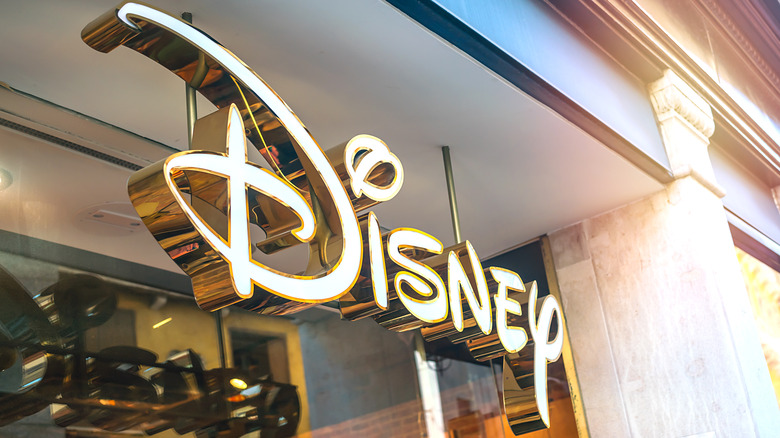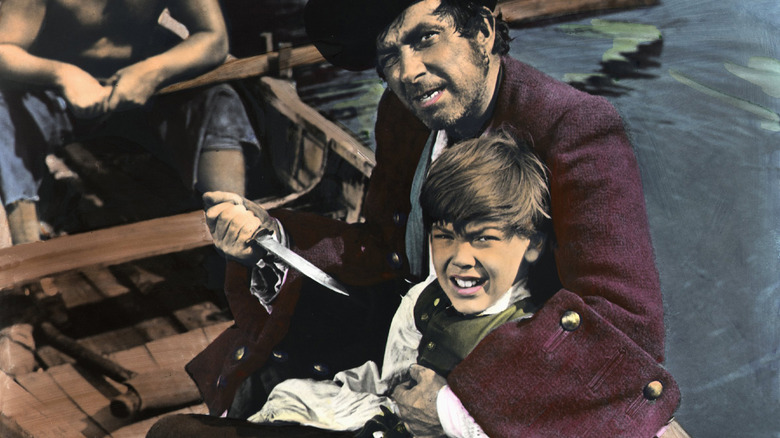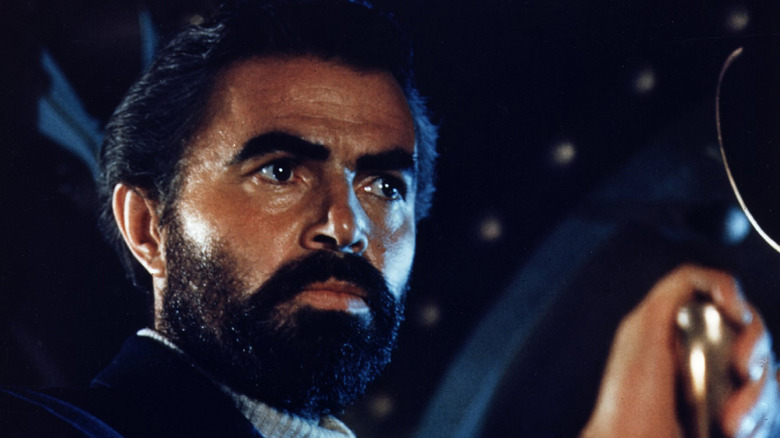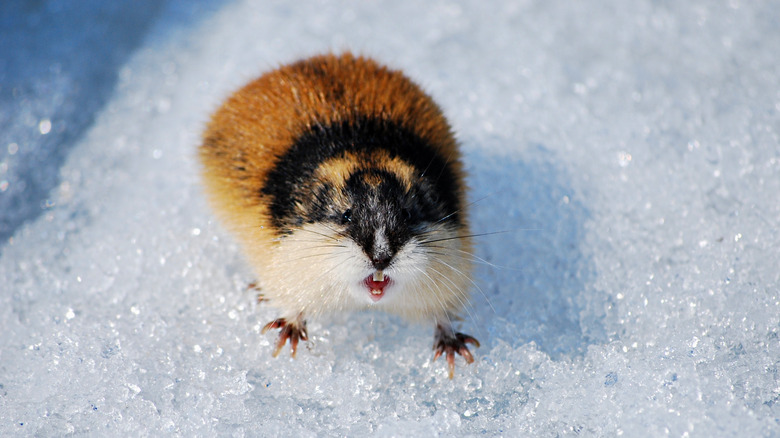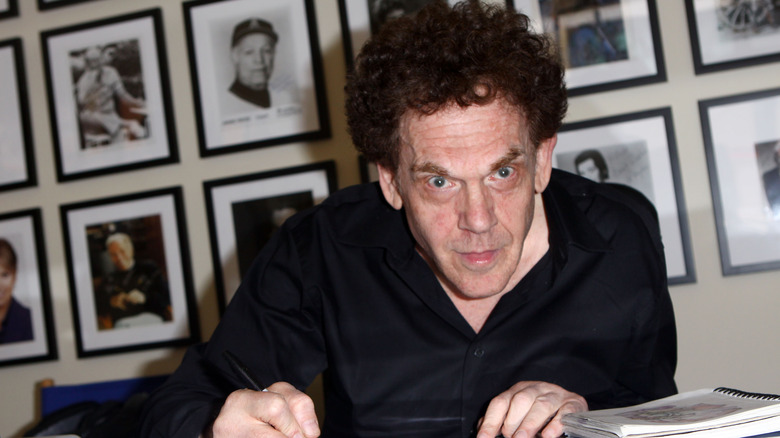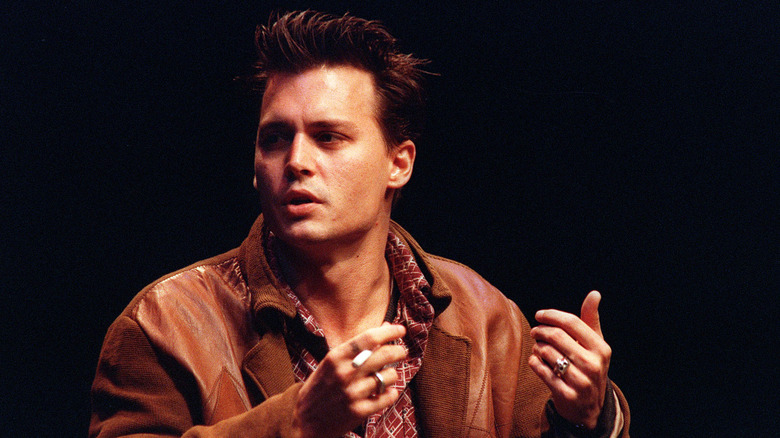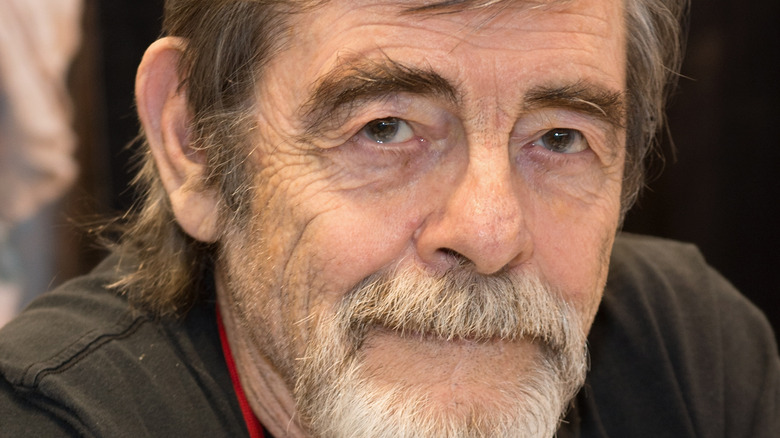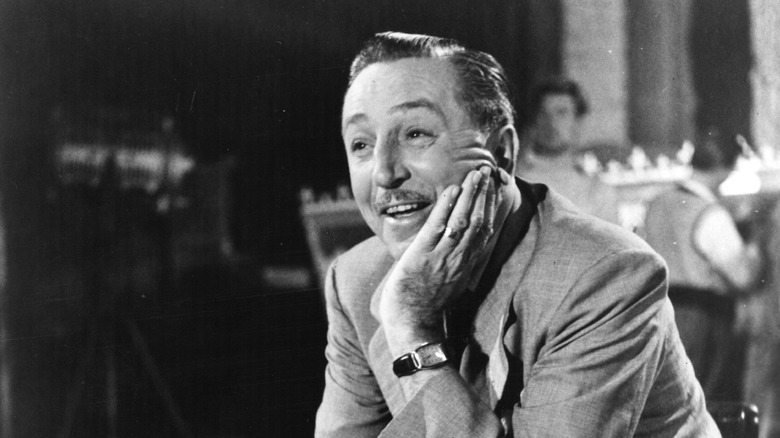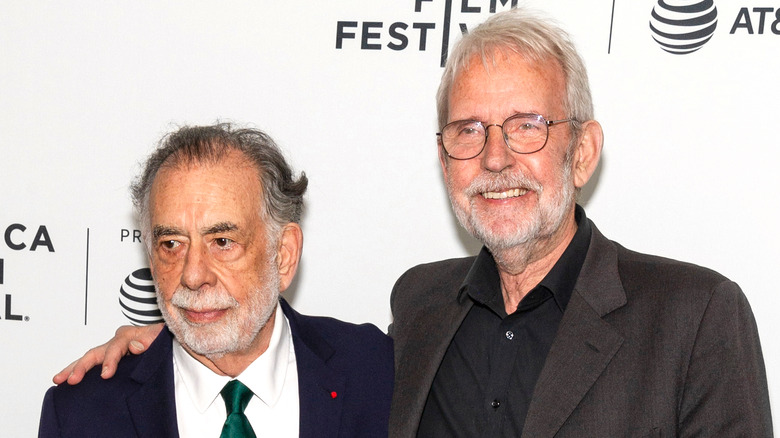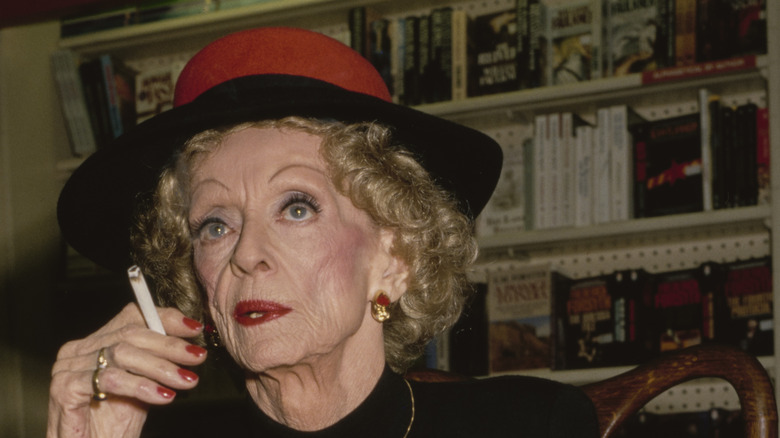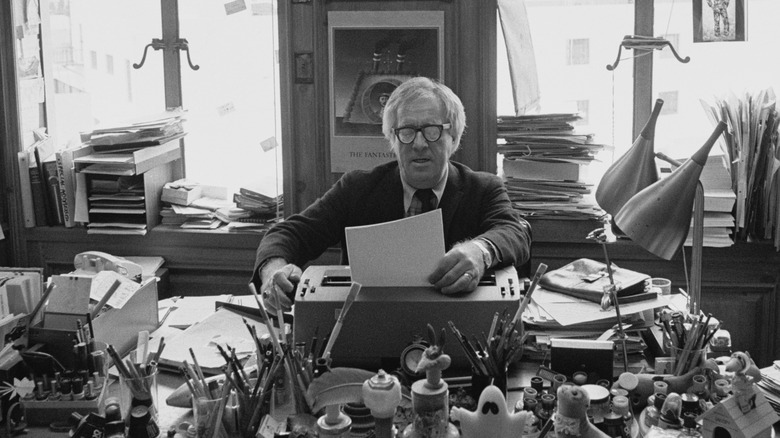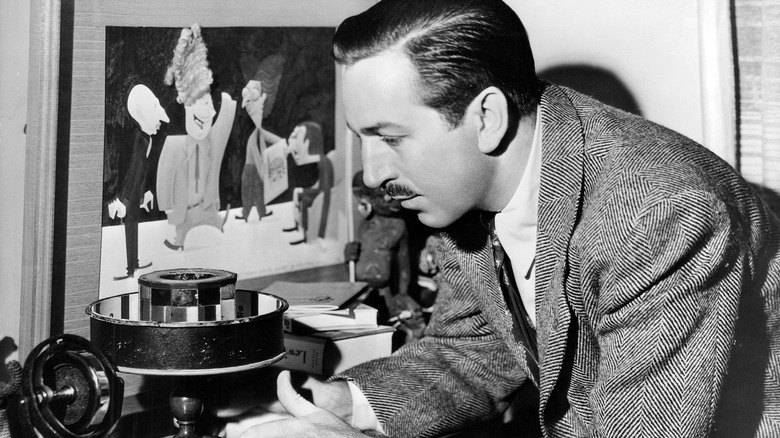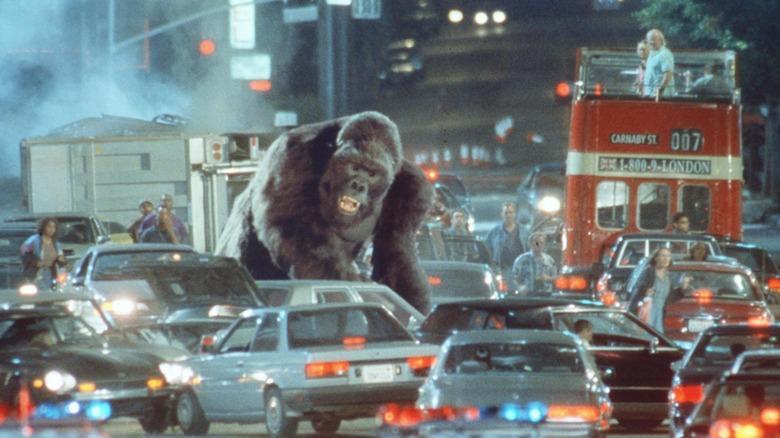Strange Things That Happened On Disney Movie Sets
You might think that, in the wonderful world of Disney, all goes according to plan. If fairy dust and the limitless possibilities of animation can't solve your problems, surely the vast resources of an international corporate juggernaut can. That kind of power would keep any blooper, legal dispute, or production oddity at bay, right?
Alas, the Magic Kingdom isn't weird-proof and never has been. From Walt Disney's earliest days as a struggling animator in Kansas to the multimedia giant of today, Disney has had its fair share of technical difficulties, quirky behavior, and stupid mistakes while filming just like any other studio. It seems even Disney magic can't make it to the screen without enduring the imperfect art and science that is movie making, and when you've been around for nearly a hundred years, those strange incidents can start to pile up. But don't just take our word for it. Here are some strange things that happened on Disney movie sets.
Disney Snuck Around British Labor Laws To Film Treasure Island
It's not necessary to emulate a pirate's lawbreaking and contempt for authority to make a pirate movie — but sometimes it helps. Walt Disney's first all live-action production was 1950's "Treasure Island," one of the best adaptations of the novel to date. As the the AFI Catalog details, the film was made entirely in Britain due to a unique situation after World War II: Revenues collected by studios in the United Kingdom were "frozen," only able to be spent on productions within the country. This meant an all-British cast, except for young Bobby Driscoll as Jim Hawkins.
Unfortunately for Walt Disney, Driscoll was a little too young at 12 to qualify for a Labour Ministry permit to work in Britain. According to the AFI Catalog, this dilemma grew into a court case that fined the studio, Driscoll, and his father £100 each and barred the lad from working in Britain. When an appeal was filed, Disney took advantage by rearranging the schedule of the film to get everything with Driscoll shot before the hearing. This dodge cost $84,000, earned a strong rebuke from the judge (Disney "brazenly violated British law"), and scared Disney off trying to bring Driscoll back to Britain for any future films — but he got everything in the can in time, and without any of the horror stories that flouting child labor laws can bring upon a production.
The Fish Story That Nearly Ruined Disney
As ubiquitous as the Disney name is, it was for much of its existence a small studio on shaky financial ground. This instability was, in part, due to Walt Disney's tendency to plow any incoming monies back into expensive productions. When he (over) spent $9 million (the most expensive film ever made up to that time) on "20,000 Leagues Under the Sea," it was a huge gamble.
The gamble seemed a disaster in the making once filming began on the legendary squid sequence. In Disney's "The Making of 20,000 Leagues Under the Sea," director Richard Fleisher is still pained by the memories of the first attempt at the scene: a washed-out pink sunset backdrop with cheesy lighting, a "practically worthless" squid puppet that fell apart while filming, and rushes that brought the Keystone Cops comedies to Disney's mind. Faced with a disaster of an action sequence, Disney told Fleisher to move on while the technicians at Disneyland built a new squid and enthusiastically approved writer Earl Felton's new concept for the battle as taking place at night in a fierce storm. The new puppet and all the wind and wave machines necessary tore the movie's budget apart, to the point Disney had to bring bankers to the set to convince them to fork over more cash. But the resulting sequence still holds up to this day.
Did They Really Kill A Bunch of Lemmings to Get A Shot?
Walt Disney loved animals. Mouseplanet.com relates how he retained warm memories of the critters on the family farm all his life, he used animals as his cartoon stars, and when he began to diversify his filmmaking in the 1940s, nature documentaries focused on wildlife proved one of the most stimulating experiments for him. The "True-Life Adventures" series that resulted were some of Disney's most profitable short subjects, according to Gregg Mitman's "Reel Nature," thanks to their low production costs. In their day, they brought in considerable praise for bringing the animal kingdom to moviegoers.
But the picture of nature presented by the "True-Life" series wasn't exactly the unvarnished truth. Running narration anthropomorphizes the animals in every one of the films. These scripts, written in advance, demanded footage that the natural world wasn't always forthcoming about, so, as Snopes notes, the film crews hired to film the animals sometimes staged what they needed. On one occasion — the filming of the 1958 "White Wilderness" – this sadly meant herding a few dozen imported lemmings off a cliff and into the water for the sake of a scene meant to illustrate the origins of the myth that lemmings commit mass suicide. Whether Disney knew or approved of the stunt is unknown, but what is known is that even the origin of the myth discussed in "White Wilderness" is complete bunk, according to Snopes.
Roger Rabbit Really Got Into Character
It's never been easy to combine live action and animation, and it was much harder back in the 1980s. "Who Framed Roger Rabbit" was a technically grueling shoot. Actors had to react to co-stars who weren't there, the director and cinematographer needed to account for where the cartoons would go, puppeteers and effects crews needed to manipulate inanimate objects that would be affected by said cartoons, and animators and effects artists labored in post-production, according to Cinema Blend, to create the animated characters and composite them into the live footage. Compared to all that work, the job of a voice actor is easy: Turn up in the recording booth, read your lines, and go home.
Except that didn't apply to Charles Fleischer, voice of Roger Rabbit himself. He was there on the set to deliver dialogue, provide sight lines for Bob Hoskins, and stand in for Roger in rehearsals. Fleischer was prepared to go the extra mile to help the film along. He told the Orlando Sentinel how he had a Roger Rabbit costume made for him to wear every day. It made for quite the sight in the studio commissary, but who can argue with his methods when the film turned out so well?
A Potentially Disastrous Meeting With Ed Wood's Wife
Yes, "Ed Wood" is a Disney film — or, at least a Touchstone one. The weirdness of "Ed Wood" was largely confined to the subject matter of a legendarily awful director surrounded by outcasts and misfits. The shoot was reportedly a relaxed, happy affair. But there was one day, related by screenwriter Larry Karaszewksi, when his writing partner Scott Alexander got a curious message from a production assistant. A little old lady had stopped by the set while on her grocery shopping. This little old lady happened to be Kathy Wood, Ed's widow.
Alexander struck up a conversation with Kathy and was happy to grant her request to meet Johnny Depp, who played the eccentric director. En route to Depp's trailer, however, Alexander remembered that they were filming a scene where Wood is in a miserable and disheveled state of drag. He and a forewarned Depp were both terrified of the impression this would give Kathy of their movie, but when cast was called, there was no avoiding her. Upon seeing Depp in his dress and smeared make-up, Kathy smiled and said, "He looks just like my Eddie!" Far from being displeased, said Karaszewksi, she went home for Wood's wallet and gave it to Depp for the rest of filming.
Age Before Beauty
As related in the making-of documentary "According to Plan," director Gore Verbinski had a saying while making the initial "Pirates of the Caribbean" trilogy: "CG is not a verb." For all the digital wizardry employed on those movies, as much of it as possible was realized through elaborate sets, amazing locations, and real stunt work. All three came together for the Cannibal Island chase in "Dead Man's Chest," when the crew of the Black Pearl break free from their bone cage only to plunge into a gorge with the cannibals on their trail.
Ti Tou Gorge was a chance discovery on a location scout. As gorgeous a location as it was, the freezing cold — and rushing — water wasn't exactly hospitable for the actors who had to be in it. Among their number was the late David Bailie as Cotton, already 67 at the time of filming. But at the end of the first day of filming in Ti Tou Gorge, it wasn't young, athletic Orlando Bloom left standing – it was Bailie and Kevin McNally, who played Gibbs, the two most senior members of the Pearl's crew. "And Gore had nothing better to do than give us close-ups," Bailie related, "because everyone else had gone off the shot!"
Walt Disney's Foul-Mouthed Flubs
Walt Disney was unique among Hollywood film producers in seeing television as a boon to filmmaking rather than competition in the early days of the medium. As described by Mouseplanet.com, after early forays into TV with hour-long specials to promote upcoming releases, Disney Studios launched the first incarnation of its anthology series, "Disneyland." It advertised films in production, aired original programming, and helped sell the public on the theme park concept, with friendly "Uncle Walt" acting as the host.
Disney was, at times, just as avuncular as he presented himself on TV, but it wasn't effortless for him to get that onto film, and missed cues and flubbed lines could bring out another side to his character. Mouseplanet records an interview with cameraman Bob Broughton, who remembered that when Disney messed up his cues, the first words out of his mouth were some choice curse words. "He goes back and we do another take," said Broughton, "[and] the page with his lines falls out on the floor. So he says 'Oh s***.' ... He does it a third time and drops the book. He says, 'Oh, s*** ... at this rate, I'm going to start flubbing the words oh s***!' And everyone bursts out into laughter."
The Lost Cameraman of Return to Oz
MGM may have brought Frank L. Baum to the masses with "The Wizard of Oz," but Disney got their hands on the rights to the rest of the Oz books. According to director Walter Murch, in an interview with Film Freak Central, those rights were soon to expire when he took a meeting with executive Tom Wilhite in 1980 and mentioned wanting to bring another of the books to the screen. Five year later, the result was "Return to Oz," not a sequel to the 1939 classic but a fresh, dark take on the world. The film was the first directing effort by Murch, a longtime film editor. He had a team of seasoned veterans to help him, including English cinematographer Freddie Francis.
A first feature of any size can be intimidating, let alone a pre-digital effects-laden cousin to a beloved classic. The Boston Phoenix reported at the time of filming that an overwhelmed Murch got a little lost and unfocused and fell behind schedule. Francis, who was a director as well as a cameraman, became so impatient that he left the film after the sequences in Kansas were shot. That proved the least of Murch's worries; he remained behind schedule, was briefly fired, and saw his passion project meet indifferent box office and mixed reviews. He hasn't directed since.
Bette Davis Couldn't Make It
"Return to Oz" was one of several darker, PG-rated fantasy films produced by Disney in the early '80s in an attempt to escape the rut that captured the studio after Walt Disney's death. "Watcher in the Woods" was another, one with impressive credentials. Its director, John Hough, was a Disney veteran who had also directed horror, and it starred screen legend Betty Davis, who marked a 50-year anniversary in show business at the time of the film's initial release in 1980.
Davis was 72 when she filmed "Watcher," and that posed a difficulty for Hough. Davis' character appeared at different ages throughout the film, and according to Hough's DVD commentary (via Showbiz Cheatsheet), she was determined to play the younger scenes herself. Make-up artists were flown to England from Hollywood to see if it could be managed, but in Hough's estimation, "[it]" knocked about twenty years off of her age, but not forty." After screening the test, Hough cleared the room and told Davis, "Bette, I don't think you've made it." In true movie-star fashion, Davis responded by taking a drag off her cigarette and snapping back, "you're god**** right."
Ray Bradbury, Totally Not The Director
Yet another of Disney's early '80s sojourns into the dark side was "Something Wicked This Way Comes" in 1983. It was a film long in the making; according to AFI, Ray Bradbury first wrote the story as a directing vehicle for Gene Kelly before turning it into a novel, and then back into a screenplay for his friend Jack Clayton to direct. Sadly, when Disney picked up the project and launched production, it meant the end of that friendship. In "The Bradbury Chronicles: The Life of Ray Bradbury," the author lamented that his friend Clayton went behind his back to hire another screenwriter who wasn't super experienced in the fantasy genre. Between the script changes and Clayton's direction, the initial cut on the film shown to preview audiences was a disaster.
After consulting with Disney executive Ron Miller, Bradbury advised rewrites and reshoots. All the cast and crew returned to service, including Clayton. But as it was Clayton's vision being reshot, the atmosphere on set was naturally awkward. He remained off to the side while Bradbury himself directed the reshoots, all the while trying not to act like he was the director. The result, the author wrote in "Bradbury Speaks," wasn't a great movie but one that was good enough.
Walt Disney - Cameraman?
"Saludos Amigos" was an odd production from the get-go. During World War II, the American government asked Walt Disney to go on a goodwill tour of South America. Disney recalled his reluctance years later to go on a "handshake tour" until the offer was amended to allow Disney to make films on Latin American subjects. A small number of handpicked staff accompanied the boss on the trip to gather material. After all the research and handshaking was done, a handful of cartoon shorts were packaged together for a 1942 release.
On the screen with those cartoons in "Saludos Amigos" was live action footage of environments, locales, and cultural practices from South America. This wasn't staged or slickly produced Hollywood photography but raw 16mm footage from the artists' tour of the continent. And according to the Walt Disney Archives, a chunk of the coverage in "Saludos Amigos" came from Walt Disney's own uncredited camera.
No Monkey Business, But One Nasty Crane
You might think that a film about a giant gorilla, filmed before digital effects became the norm for creating such beasties, would have stories of strange happenings and near-fatal accidents involving a gorilla. Not so with the 1998 remake of "Mighty Joe Young." All the monkey business was safely handled through suit actors and animatronics from Rick Baker and a handful of CG shots (via the Sun Sentinel).
No, the real disaster for "Joe" was thanks to a crane. During filming, a camera platform was mounted 18 feet above ground with cinematographer Don Peterman aboard. The crane supporting the platform snapped. According to the Los Angeles Times, Peterman and the camera operator were thrown to the ground. Peterman suffered a broken leg, broken ribs, and head injuries, but he and the operator both survived. Despite the accident, Peterman managed to complete the film and get in one more credit ("How the Grinch Stole Christmas") before retiring.
